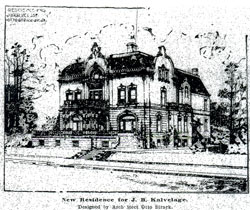NEW RESIDENCE FOR J. B. KALVELAGE
Sentinel Jan 17, 1897
 |
The new residence for J. B. Kalvelage of the Hoffmann & Billings Manufacturing Company on Cedar Street near 24th street, begun several weeks ago, will be one of the best residences on the Upper West side when completed. It is designed in the Baroque style which is akin to the Rococo and presents a pleasing appearance in the soft tones and pressed brick of the terra cotta. The base will be of faced stone and the first story of pressed brick of a buff color, while above that the brick will be a motled gray. A striking feature of the front is the central collanade, which rised to the cornice. The lower pillars are borne by groups of Alantes, while those above present a clear shaft. A wide porch extends on either side of the central portico to the stairways at the sides. The style is carefully followedc in the ornamental trimings of terra cotta and iron which greatly releive the flat walls.
The building is very regular and little space is given to nooks and crannies. It is 50 feet by 55 feet, nearly square, and the attractivfeness of the exterior depends entirely upon the ornamentation and the central set of columns. The interior is arranged in harmony with the regular shape of the building. A wide hallway extends through the center of the main floor to a wide staircase at the rear.This will be finished in quartersawed oak with heavily carved pillars and beams. To the right is the library with the music room at the rear of it, and to the left the parlor and dining room. The labrary and music room are to be finished in birch with mahogany stain, and the other rooms in white oak with polished white oak floors. To the rear of the dining room is supporting a fret wrok in harmony with the other appointments. The kitchen and pantries are behind the central stairway and are to be equipped with permanent apparatus.
The second floor contains four bedrooms and a guest chamber. The bedrooms for the family and nurse are grouped about a cnetral hallway and each has a separate access to the baths. The entire floor will be finished in white oak, the same as the main floor. The thrid floor is occupied by a large amusement ball, billard room, anhd the Servants appartments and baths. Architech Otto Strackehas bestowed a great deal of attention upon the detail work of the ornamentation. Throughout the building an effort has been made to adapt a peculiar style of mediaeval architecture to the requirements of modern residence, without glaring inconsistencies. The fireplaces, balustrades, plasters and other parts are especially designed and all form a highly artistic interior.
The material and appliances through out are selected. A hot water system of heating and ventilation will be used and fuel gas and electric light service put in. The mantles and basins are to be of polished stone and the bathrooms will be tiled. The work is now well advanced and the house will be completed in the spring, Architect Otto Stracke, who prepared the plansis superintending the construction. The estimated cost of the structure is $30,000.